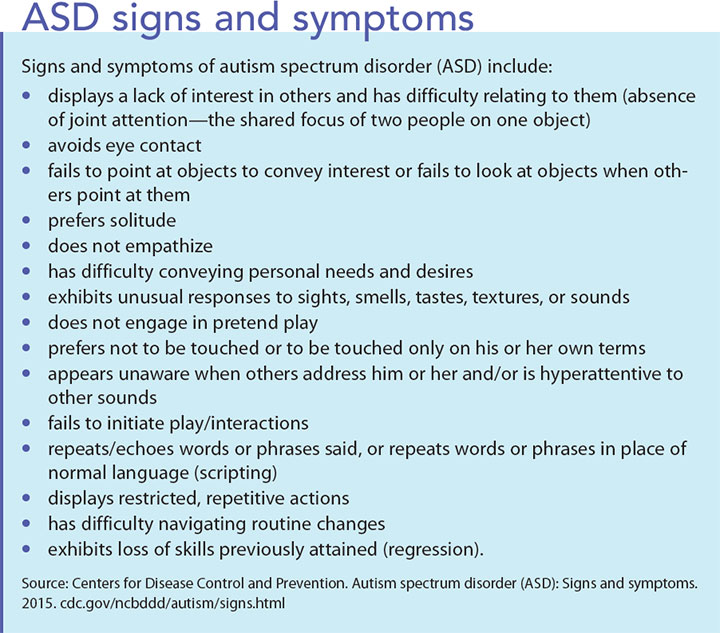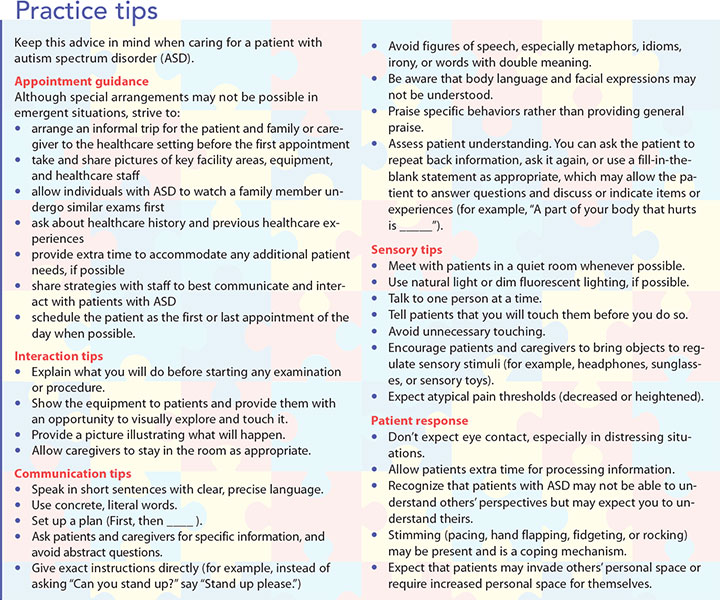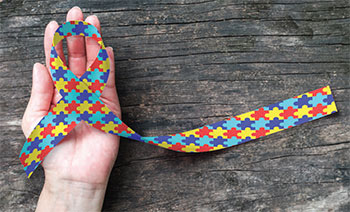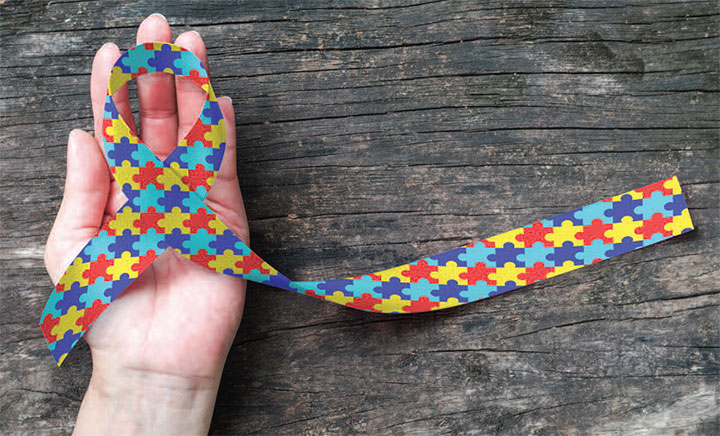Successful care depends on communication with patients, families, and caregivers.
Takeaways:
- Optimizing health encounters for patients on the autism spectrum (ASD) requires an individualized approach.
- Understanding similarities among people with ASD may improve communication, interactions, and health outcomes for patients, families, and communities.
By Jayne Jennings Dunlap, MSN, FNP-C
Editor’s note: April is National Autism Awareness Month. Learn more.
Have you ever feltunprepared to navigate nursing encounters with patients with autism spectrum disorder (ASD)? If so, you’re not alone. Many healthcare professionals report a lack of self-confidence when caring for patients with ASD.
In the 1970s, autism prevalence was estimated to affect one in 10,000 people. Currently, the Centers for Disease Control and Prevention (CDC) reports that one in 68 children are identified with ASD. People with ASD have been appraised to have more unmet healthcare needs than any other special-needs population. These health inequities are primarily attributed to significant socialization and communication barriers. As the largest and most trusted workforce in healthcare, nurses must be prepared to address this vulnerable group across all settings throughout the lifespan.
About ASD
Differences define humans as individuals, but unlike an outward physical attribute, ASD is a cognitive processing disorder that isn’t always detectable by patient appearance. Scientific advances have uncovered behavioral variances that frequently develop during infancy and may allow for earlier detection of the disorder. The American Academy of Pediatrics recommends universal ASD screening at 18 and 24 months old. Early developmental changes to cognitive tracking patterns can alter links between areas of the brain in those with ASD. This atypical cognitive wiring can make transferring information from one situation to another difficult for those with ASD.
Symptoms of ASD contribute to challenges in communication, socialization, and sensory processing. Some people with ASD demonstrate repetitive behaviors, restricted interests, and distinctive learning styles. These symptoms span a broad range and are unique to each patient. (See ASD signs and symptoms.)


Patients showing signs of ASD may or may not be diagnosed with the disorder. Some individuals require substantial assistance with activities of daily living, but others don’t. Individuals with ASD don’t necessarily have decreased intelligence; in fact, giftedness may be present in some children and adults with ASD.
Despite vast differences within this population, awareness of similarities (including difficulty communicating, forming relationships with others, and understanding abstract concepts) that are common among individuals with ASD can augment and guide nursing practice. Working with patients and their caregivers to identify individualized strategies is key to optimizing health outcomes.
Practice partnerships
Nurses should consistently seek care partnerships with patients and caregivers. However, this may be difficult when uncertainties in interpersonal communication prevent a clear understanding of defined goals and guidelines. Patients with ASD who struggle with social communication may find that requesting special accommodations is difficult, so use individualized strategies to address limitations that create barriers to healthcare.
Individuals with ASD interpret the world in an exceptional way, which may contribute to communication challenges. The burden is on us to understand them just as they must try to make sense of a “normal” world. (See Practice tips.)


Pediatric considerations
Healthcare professionals’ interactions with children can promote caregiver compliance with prescribed therapies and treatments. Parents appreciate the rapport nurses build with their children with ASD. For example, caregivers have noted the importance of using their child’s name at the beginning of every interaction. And when you position yourself at the child’s eye level, you indicate that he or she is a participant in care. This inclusion empowers those who can to contribute during a healthcare visit. When you provide these opportunities, you foster a chance for children with ASD to practice healthcare engagement.
Adult considerations
Under the Americans with Disabilities Act, nurses must accommodate the specific needs of patients with ASD. Use individualized strategies to address limitations that may create barriers to healthcare. Patients with ASD who struggle with social communication may find that requesting special accommodations is difficult. The Autism Healthcare Accommodations Tool can help patients create personalized accommodation reports for nurses and other healthcare professionals. Your proactive responses to accommodation requests can save time and resources, improve therapeutic relationships, facilitate effective healthcare, and help improve health outcomes for patients with ASD.
Caregiver considerations
A holistic approach prioritizes treatment of the whole person and includes the family. If a patient with ASD can’t communicate, ask caregivers for information about his or her particular abilities and needs. Encourage parents, guardians, conservators, and surrogates to solicit the patient’s priorities and values. If you can’t obtain a plan of action, urge healthcare decisions based on estimates of what patients with ASD would choose if they could be involved, and keep these tips in mind:
- Always acknowledge patients’ presence and assume that they understand your words, even if they may not be able to express understanding. This will help reassure the family.
- Know that the pervasive nature of ASD can be taxing on the entire family.
- Be aware that an ongoing grieving process associated with ASD may occur within the family.
- Assess family concerns and provide appropriate support.
- Focus on special opportunities, not negative life predictions.
- Explore favorable actions relevant to the healthcare visit.
ABCs of behavior
You may not fully understand the challenging communication and atypical behaviors associated with ASD, but don’t dismiss them. All behavior is a form of communication. To help overcome communication challenges, consider the ABCs of behavior:
- Antecedent—prompting of behavior (before)
- Behavior—action/response (during)
- Consequence—result of behavior (after).
For example, if a patient appears destructive, could he or she be using behavior to fulfill a need? Don’t put yourself in harm’s way during a “meltdown,” but look for the function of a behavior and help the patient meet his or her own needs appropriately.
In many cases, common medical problems present atypically in those with nontraditional communication or mental functioning. Illness may appear only as a change in baseline function or behaviors. Caregivers are valuable resources to help you understand normality in patients with ASD.
When providing care to patients with ASD, consider a full list of possible differential diagnoses, including common psychosocial and medical causes. Mental illness may be only one possible cause of aggression or challenging behavior; many patients with ASD have undetected or undertreated medical conditions that contribute to their behavior.
Ask the following questions:
- What occurred before the patient became distressed?
- How did others react?
- How did the patient respond to those reactions?
This analysis can provide insight into how patients with ASD are attempting to fulfill their needs and communicate their desires. Consider this example: A patient with ASD becomes combative in the bathroom. An X-ray reveals a complete fecal impaction. Investigating what occurred before, during, and after the behavior change leads to successful medical treatment.
Creating trust


Facilitate information exchange in a manner consistent with the patient’s ability to communicate. Communication skills vary between modes of communication (for example, written vs. spoken language), and differences can exist between receptive vs. expressive communication. Some patients may understand spoken language but aren’t able to speak. Others may speak fluently but can’t accurately process auditory information, or they may simply repeat words they’ve heard. Consider using supportive or alternative communication, such as picture-based systems, text-based systems, sign language, or other signs or behaviors. These systems may be stand-alone or exist as programs on tablets, smartphones, or paper.
ASD treatment
ASD has no cure. However, early detection and intervention with evidence-based treatments can positively affect outcomes. Applied behavioral analysis (ABA) is an evidence-based treatment that uses behavior science to motivate learners by breaking down complex tasks into smaller steps. Principles used in ABA address the core deficits of ASD and teach communication, socialization, and adaptive skills. ABA therapy benefits children and adults with ASD and includes caregiver training to ensure consistent and lasting improvement. To find a credentialed ABA provider near you, visit bacb.com. Collaborative treatment with other disciplines, such as occupational and speech therapy, has been shown to help patients with ASD acquire skills.
The goal of ASD management is to maximize functionality, improve life quality, and promote independence. Nurses are a vital part of this process. Advocacy and resource sharing increase healthcare access and treatment, reducing health disparities for those with ASD.
Importance of early intervention
Perceptions of ASD are shifting, evolving from a lifelong condition with a poor prognosis to one in which significant developmental gains are realized into adulthood. Providing early childhood experiences that enhance learning improves developmental and cognitive trajectories.
The CDC recommends that caregivers first visit their child’s healthcare provider, who can make referrals to specialists for evaluation and confirmation of ASD. Simultaneously, caregivers should call their state’s public early childhood system to request a free educational evaluation. This call doesn’t require a referral or a medical diagnosis. The Early Childhood Technical Assistance Center, a premier resource for understanding the Individuals with Disabilities Education Act, provides state-specific early childhood special education and early intervention information.
Looking ahead
Nursing pioneer Dr. Loretta Ford (cofounder of the first nurse practitioner program) recently stated, “The art of nursing, perhaps more than the science, offers vulnerable groups something they need most: hope. The use of our presence with all its holistic emotional intelligence, caring, compassion and competence tells people that they are valuable and valued, unique, and worthy fellow human beings. Transformations can occur if vulnerable individuals are encouraged to find, focus and harness their strengths. As nurses, we can help them become invigorated, energized and emboldened to determine their future for themselves in health and in life” (email communication, April 2017). One interaction at a time, nurses can successfully advocate for individuals with ASD.
Jayne Jennings Dunlap is a family nurse practitioner at Baylor Scott and White – Belton South Family Medicine Clinic in Belton, Texas, and a doctor of nursing practice student at Texas Christian University in Fort Worth.
Selected references
Academic Autistic Spectrum Partnership in Research and Education. AASPIRE healthcare toolkit. autismandhealth.org
American Nurses Association. Intellectual and Developmental Disabilities Nursing: Scope and Standards of Practice. 2nd ed. Silver Spring, MD: American Nurses Association; 2013.
American Psychiatric Association. Diagnostic and Statistical Manual of Mental Disorders (DSM-5). 5th ed. Washington, DC: American Psychiatric Association; 2014.
Centers for Disease Control and Prevention. Autism spectrum disorder: Screening and diagnosis. 2015. cdc.gov/ncbddd/autism/screening.html
Centers for Disease Control and Prevention. Autism spectrum disorder (ASD): Facts about ASD. 2016. cdc.gov/ncbddd/autism/facts.html
Daniels AM, Halladay AK, Shih A, Elder LM, Dawson G. Approaches to enhancing the early detection of autism spectrum disorder: A systematic review of the literature. J Am Acad Child Adolesc Psychiatry. 2014;53(2):141-52.
Dawson G, Bernier R. A quarter century of progress on the early detection and treatment of autism spectrum disorder. Dev Psychopathol. 2013;25(4 Pt 2):1455-72.
Hodgetts S, Zwaigenbaum L, Nicholas D. Profile and predictors of service needs for families of children with autism spectrum disorders. Autism. 2015;19(6):673-83.
Nicolaidis C, Kripke CC, Raymaker D. Primary care for adults on the autism spectrum. Med Clin North Am. 2014;98(5):1169-91.
Yochum A. Autism spectrum/pervasive developmental disorder. Prim Care. 2016;43(2):285-300.
ant4-Autism-329



















1 Comment.
Lack of communication with an autistic child makes it more severe. Interaction in a low and pleasant and friendly voice with an autistic child will be always helpful in decreasing his sensitivity.